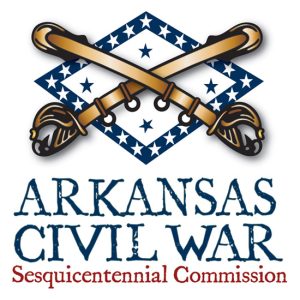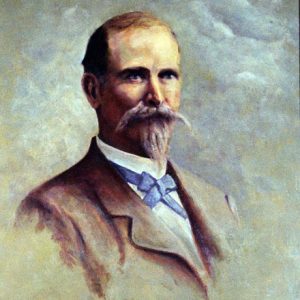calsfoundation@cals.org
Skirmish at Tulip
| Location: | Dallas County |
| Campaign: | None |
| Date: | October 11, 1863 |
| Principal Commanders: | Colonel Powell Clayton (US); Colonel Archibald Dobbins (CS) |
| Forces Engaged: | Men from the Fifth Kansas and First Indiana Cavalry Regiments (US); First Arkansas Cavalry Regiment (CS) |
| Estimated casualties: | 1 injured (US); Unknown (CS) |
| Result: | Union victory |
The October 11, 1863, Skirmish at Tulip was a small action in which Union colonel Powell Clayton led men from the Fifth Kansas and First Indiana Cavalry Regiments in an attack that routed Colonel Archibald Dobbins’s First Arkansas Cavalry Regiment, capturing men and equipment. Also captured was a flag that became a prized artifact in the collection of the Old State House Museum.
Following the Union occupation of Little Rock (Pulaski County) on September 10, 1863, a delegation of citizens from Pine Bluff (Jefferson County) came to Little Rock and asked General Frederick Steele to establish a garrison there to protect property and keep citizens from being conscripted into the Confederate army. Steele duly ordered Clayton’s small cavalry brigade to Pine Bluff, and by September 19 the Fifth Kansas had occupied several deserted buildings there, to be joined a few days later by the First Indiana Cavalry.
While the bulk of Arkansas’s Confederate forces fell back to Arkadelphia (Clark County) after Steele occupied Little Rock, Rebel cavalry kept a watchful eye on Union movements. Choosing to maintain the tactical initiative, the aggressive Clayton picked 300 men from his brigade, along with four mountain howitzers, and set out in search of Dobbins’s troops. Around 4:00 a.m. on October 11, 1863, they found the Confederates camped at Tulip (Dallas County) and attacked. An after-action report stated, “The entire rebel force, six hundred (600) strong, fled in dismay, leaving nearly everything behind them; their tents, wagons, arms sabers, pistols, and one battle flag.” Steele himself noted: “This affair created great consternation at Arkadelphia.” Dobbins fell back on the lower Arkadelphia Road with about 200 men. He wrote, “The enemy drove us from Tulip this morning about 4 o’clock. I have not yet ascertained their force; they have artillery.” Clayton’s troops returned to Pine Bluff around sunrise, their only casualty being Clayton, who was hit a glancing blow by a bullet.
The First Indiana claimed the captured flag and returned it to its home state as a battle trophy with a note saying, “Headquarters Ind. Cav., Pine Bluff, Ark. October 20, 1863, This Rebel flag was captured at Tulip, Ark. October 11, 1863, from Col. Dobbins if [sic] Ark. Vols., by the 1st Indiana Cavalry.” It remained in Indiana for ninety-nine years before being repatriated to Arkansas by the governor of Indiana in 1962 during the Civil War centennial, a period in which many flags were returned from Northern states as gestures of conciliation with their former foes. The flag is now in the collections of the Old State House Museum in Little Rock.
While a relatively minor action, the Skirmish at Tulip increased Confederate awareness of the presence of an aggressive Union force at Pine Bluff and may have influenced Brigadier General John Sappington Marmaduke’s decision to attack Clayton’s men in the October 25, 1863, Action at Pine Bluff. It also resulted in the survival of a unique artifact of the Civil War in Arkansas.
For additional information:
Christ, Mark K. Civil War Arkansas, 1863: The Battle for a State. Norman: University of Oklahoma Press, 2010.
“Flag, Confederate—Dobbins’ 1st Arkansas Cavalry.” Old State House Museum. http://collections.oldstatehouse.com/objects/4664/flag-confederate–dobbins-1st-arkansas-cavalry?ctx=03a74523-bb04-4d63-bb61-5a9e5f17a3af&idx=0 (accessed October 7, 2020).
The War of the Rebellion: A Compilation of the Official Records of the Union and Confederate Armies. Series I, Vol. 22, Part 2. Washington DC: Government Printing Office, 1891.
Mark K. Christ
Arkansas Historic Preservation Program


 ACWSC Logo
ACWSC Logo  Powell Clayton
Powell Clayton  Archibald Dobbins
Archibald Dobbins 



Comments
No comments on this entry yet.